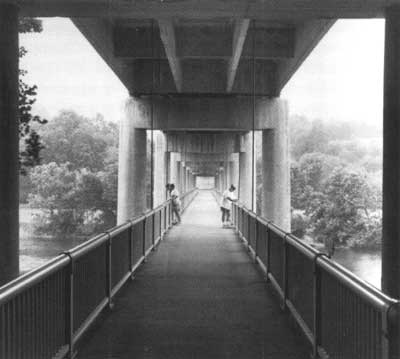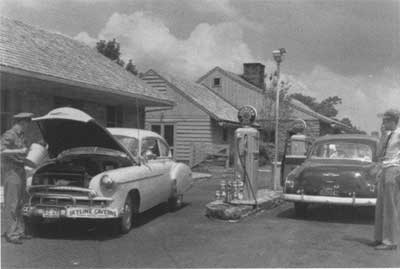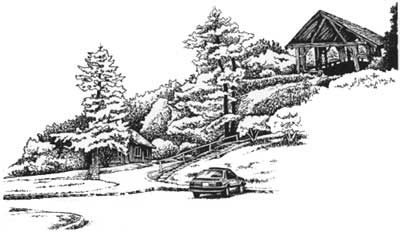 | ||
 | ||
 | ||
 | ||
 | ||
 | ||
 | ||
 | ||
 | ||
 | ||
 | ||
 | ||
 | ||
 | ||
 | ||
 | ||
 |
 |
 |
Blue Ridge Parkway
Virginia and North Carolina

Walkway beneath the James River Bridge, 1996. |
OVERLOOKS
Most of the parkway's 264 scenic pull-offs provide stunning vistas and panoramas of near and distant mountain scenery; local residents often called them "balconies" as they were just that, a place from which to take in the view. Other pulloffs provide parking to allow motorists to inspect an interesting resource or take a stroll on one of the parkway trails. The overlook locations were carefully selected during the initial reconnaissance surveys.
There are two basic types of overlook. The primary type affords a picturesque vista, often carefully framed by landscape plantings. A second type features interesting cultural or natural resources, often interpreted by a gunboard sign or interpretive easel, or provides access to a hiking trail. The overlooks may be simple road widenings, "eyelid" overlooks with the parking separated from the roadway by a planted or grassy island, or more elaborate spur or loop roads away from the parkway.

The service station area at Doughton Park offers food, fuel and camping supplies, ca. 1950. |
BUILDINGS
The parkway preserves a variety of historic buildings, either as interpretive exhibits or as picturesque roadside features. With the exception of the imposing neoclassical estate of textile magnate Moses Cone, the structures tend to be modest structures, mostly simple log cabins. The early parkway planners thought the log cabin symbolized pioneer Appalachia, and preserved or relocated a good number of log structures to points along the road. Ironically, they removed a number of earlier frame houses because they did not meet their stereotypical vision of the Appalachian past.
For its own construction, parkway planners adopted their own variant of the prevailing "rustic style" of architecture adopted in the national parks. They wanted their own structures to reflect the architecture of the region, and consequently took on the forms of cabins, sheds and barns in order to enhance a "backwoods feeling." Structures would employ timber beam construction, shake roofs, stone chimneys and exterior porches. Even the "driftwood gray" color was specified to present a weathered appearance.
With few exceptions, even modern structures along the parkway, such as the 1989 Linn Cove Visitor Center or the 1999 Everhardt Headquarters Building at Asheville continue to reflect pioneer architecture through their use of native materials, allowing them to harmonize with the rugged landscape.

The timber shelter at Craggy Gardens typifies the rustic style employed on the parkway. |
| Introduction | Acadia | Blue Ridge Parkway | Colonial Parkway | Generals Highway | George Washington Memorial Parkway | Great Smoky Mountains | Mount Rainier | Rock Creek and Potomac Parkway | Shenandoah's Skyline Drive | Southwest Circle Tour | Vicksburg | Yellowstone | Yosemite | Discover History |
